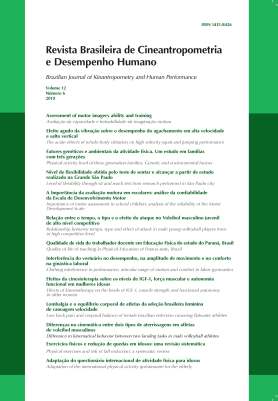Effects of kinesiotherapy on the levels of IGF-1, muscle strength and functional autonomy in older women
DOI:
https://doi.org/10.1590/1980-0037.2010v12n6p451Abstract
The levels of insulin-like growth factor-1 (IGF-1), muscle strength and functional autonomy tend to decrease with age. The objective of this study was to evaluate the effects of kinesiotherapy on IGF-1 levels, muscle strength and functional autonomy in older women with musculoskeletal dysfunction. A sample of 52 women was randomly divided into two groups: an experimental group (age: 68.52 ± 4.68 years, BMI: 28.05 ± 20.83) submitted to 12 weeks of exercise, and a control group (age: 67.52 ± 7.34 years; BMI: 26.96 ± 4.01). Serum IGF-1 levels were measured by a chemiluminescence method. Muscle strength was evaluated by one-repetition maximum (1-RM) testing of hip flexion (HF) and extension (HE) and shoulder flexion (SF) and extension (SE). The GDLAM protocol was used for the evaluation of functional autonomy. Repeated measures ANOVA showed an increase in IGF-1 levels after kinesiotherapy in the experimental group (? = 19.74 ng/ml, p = 0.028). In the experimental group, muscle strength for shoulder flexion (?SF = 1.26 kg, p = 0.001) and extension exercise (?SE = 1.90 kg, p = 0.0001) and for hip extension (?HE = 2.52 kg, p = 0.0001) and flexion (?HF = 2.82 kg, p = 0.0001) exercise increased after therapy. IG scores were reduced in the experimental group after therapy (? = -16.73, p = 0.004). In conclusion, resistance exercise can improve IGF-1 levels, muscle strength and functional autonomy in older women with musculoskeletal dysfunction.Published
2010-09-05
Issue
Section
Original Articles



